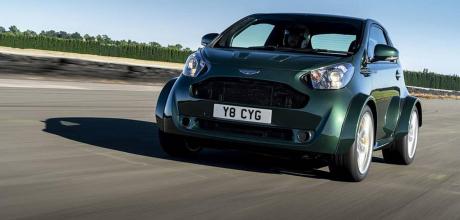Is it a classic? Aston Martin Cygnet

As sure as night follows day and cream follows jam*, it was inevitable that the Aston Martin Cygnet would appear in the issue following the Frazer Tickford Metro. Concluding his review of the luxo Metro, Richard Heseltine said: “There is something appealing about a small car with big car luxuries and the Frazer Tickford is both of those things and more. It isn’t as though the idea was lost on Aston Martin Lagonda, either. Think of it as the forerunner of the Cygnet. And then stop thinking.” Only the thinking didn’t stop in issue 11. On the contrary, it’s time to argue the case for the Cygnet’s inclusion in the big book of modern classics. Was the Cygnet really such an ugly duckling?
Aston Martin’s claim that it was a ‘luxury solution to urban mobility’ was a little disingenuous. Then again, using a line about it being a ‘luxury solution to cut average CO2 emissions before the company gets a slap on the wrist from the EU’ is a far less evocative opening statement to stick in a brochure. The fact is, the Cygnet was born to enable Aston Martin to keep building DBs and the like.

Building a small car from scratch was out of the question, not least because it would have cost the punter far more than the £30,995 starting price. Creating a luxury version of the Toyota iQ was no different in spirit to swanky small-scale starlets like the Tickford Metro, Vanden Plas 1500 and Wood & Pickett Minis, not to mention the Baccara and Monaco versions of the Renault 5 and Clio.
Using the iQ for the opulent makeover made a lot of sense. Aston Martin knew it could trust the Toyota mechanicals, while the individual styling set it apart from other city cars. In Pearl White, it looked less like something you’d drive and more like something into which you’d plug a pair of headphones. A city car for the iPod generation; it’s a wonder it wasn’t built in Silicon Valley.
On the inside, the iQ featured a clever asymmetric dashboard, which allowed the front-seat passenger to sit further forward, freeing up space for an adult to sit in the back. Impressive for a car just three metres in length, even if space behind the driver was at a premium. A boot offering a paltry 32 litres of luggage space meant that the iQ wasn’t in line to win any awards for practicality at the What Practical Hatchback Should I Buy? magazine awards, but it didn’t prevent the iQ from completing a makeover of Stars in Their Eyes proportions. ‘Tonight, Matthew, I’m going to be an Aston Martin.’
Anyone who says the Cygnet isn’t a proper Aston Martin should consider the 150 hours it took to complete the transformation. That’s just 50 hours short of the time spent building each DB9. On the outside, all panels except the roof were bespoke to the Cygnet, with seven coats of paint used to create a glass-like finish. The aluminium grille, side strakes, inset badges and bespoke door handles were straight out of the top drawer of Aston Martin trimmings. On the inside, the cabin was swathed in Alcantara and seven hides of leather, the same as you’d find in a DB9. The iQ architecture remained, but it was hidden behind Aston Martin dials, steering wheel, gear lever and stitched leather. Options were plentiful, allowing the customer to create anything from tasteful to tasteless. Why limit yourself to colours that sounded suspiciously like the team at Gaydon’s favourite pubs, when you could paint your Cygnet in any colour you like? In case you’re wondering, the standard colours included Black Bear, Silver Jubilee, White Horse, Red Lion, Yellow Kangaroo, Grey Bull, Blue Anchor and Silver Fox. Maybe you’d need to be under the influence to spend £30k on a poshed-up iQ.
Fiddling with the 97bhp 1.33-litre VVT-i engine would have been nonsensical when the Cygnet’s raison d’être was to lower the company’s average CO2 emissions. As a result, the Cygnet could hit zero to brasserie in 11.8 seconds with a six-speed manual gearbox, or 11.6 seconds in CVT auto form. Or could it? Given that the Cygnet tipped the scales at 988kg, some 58kg heavier than the lightest iQ, could it really hit 62mph in the same time? Aston Martin must have sourced its leather from cows on a SlimFast diet.
A decade on, the Cygnet is well on the way to classic status. Prices fell to around £20,000 before returning to the original list price, so at least £30k is required to buy one today. Go to the Auto Trader website and search for cheap Aston Martins – you’ll need to scroll through three or four pages before reaching the first Cygnet. It helps that sales fell a long way short of the projected 1500 a year. Early reports of 400 UK pre-orders seemed wide of the mark, but an enterprising dealer could be hiding a couple of hundred cars in a London basement. As it stands, there are around 150 registered in the UK, which helps to keep prices high. It may have been created to satisfy emission standards, but Aston Martin’s approach to building a luxury small car was a breath of fresh air.

